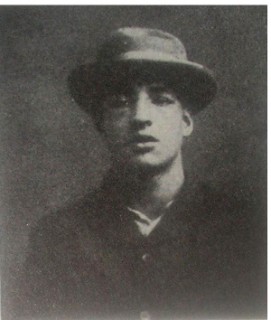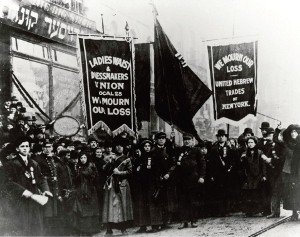Dopey Benny
Did these tough, violent men in our past reflect some failing in the Jewish character, or were these children of our immigrant forefathers trying to achieve the "American Dream" the only way they knew how?
The first thing you notice about him is the eyes. He looks out at you across an unbridgeable chasm of time and space from one of the few known photographs of him in existence. The photo is old, grey, grainy and dark — probably taken as a mug-shot by the police after one of his many arrests — yet you can't help but notice those eyes. Both eyelids are puffy, a possible sign of drink, drugs or maybe just living rough at the very edge of society. And the eyelids both droop somewhat, giving his face a look that might be sleepy, sad orjust sullen. Some say that the droop might have been caused by an adenoidal condition; no one knows for sure.
The picture could have been taken any time between 1910 and the start of the First World War. It portrays a young Jewish man in a battered hat and cheap clothes. His name was Benjamin Fein. Born in 1889, he grew up and lived in the squalid, teeming, tenement-choked streets of New York's Lower East Side. He was not a scholar, not a yeshiva boy, nor even an aspiring young striver with dreams of becoming a doctor, lawyer or vaudeville entertainer. Benjamin Fein was a gangster, one of the early Jewish gangsters, long before Prohibition would make celebrities of later Jewish gangsters like Arnold Rothstein and Dutch Schultz, and Hollywood movie characters out of Meyer Lansky and Bugsy Siegel. The droopy eyes and the sleepy expression gave him the name by which he was known and feared on the streets of pre-WWI New York: "Dopey Benny".
Jewish gangsters? Yes, we had them, and they were not particularly lovable guys. From the late nineteeth century on up to the Second World War, Jewish mobsters and racketeers were the core and driving force of organized crime in the United States. The network of killers in what came to be known as "Murder, Inc." was composed almost entirely of Jews. Did these tough and sometimes pathologically violent men in our past reflect some failing or flaw in the Jewish character, or were these children of our immigrant forefathers simply trying to achieve the "American Dream" the only way they knew how? Another long gaze at the rough, ravaged face of Dopey Benny provides no answer to this question, but American history does.
Gangsterism and organized crime have provided a rung in the ladder of upward mobility to virtually every incoming ethnic group in the U.S. since the Potato Famine of the 1840s poured waves of impoverished, half-starving Irish immigrants onto American shores and into American cities. Martin Scorcese's film, The Gangs of New York, reflects the period in the mid-19th century in which young Irish men had organized themselves into gangs —first to defend themselves against an established hostile Protestant population, then to forge alliances and get out the votefor Democratic party politicians who wanted to exploit them, and finally to become politicians themselves and assume control of American urban politics.
As the Irish were moving up in the 1880s, we were moving in. In newspaper reports of criminal activity from this period, Irish names and Irish gangs began slowly to disappear, to be replaced by a new generation of criminals whose names were unmistakably Jewish —Monk Eastman, Joseph "The Greaser" Rosenzweig, Max "Kid Twist" Zwerbach, Jack "Big Jack" Zelig, Nathan "Kid Dropper" Kaplan and, last but not least, Dopey Benny Fein.
Benjamin Fein grew up in a neighborhood where life was a lot grimmer and more grasping than it was later romanticized to be in sentimental memoirs and movies. He learned as a child to be a pickpocket and petty thief. Utilizing the superb organizational skills that would later make him famous, Benny formed his own gang of robbers in 1905, whose activities were interrupted by Benny's being sent to reform school several times until finally serving three and a half years at Sing Sing prison for armed robbery.
Upon his release, Benny joined the gang of "Big" Jack Zelig, which he soon came to lead when Zelig was gunned down on a 14th St. streetcar. Whereas Benny's predecessors Monk Eastman and Jack Zelig had dabbled in labor racketeering in addition to a broad spectrum of criminal activities, Benny, the son of an immigrant tailor, decided to focus on labor thuggery and extortion in New York's garment district. He was soon earning upwards of $20,000 a year renting his gang out as shtarkers or goons, for both labor unions and manufacturers. His underlings could be seen protecting strikers one day, and breaking strikers' heads the next.
And then, on March 25, 1911 at around 4:40 pm, a fire began at the Triangle Shirtwaist Company factory on the corner of Greene Street and Washington Place. Located on the eighth, ninth and tenth floors of a large downtown factory building, the Triangle Company employed around 500 young immigrant Jewish and Italian girls, sitting at sewing machines for nine hours on weekdays and seven hours on Saturdays, making women's blouses or shirtwaists, earning anywhere from $7 to $10 per week.
The fire began in one of the cutting bins on the eighth floor, started perhaps by a cigarette or maybe by the engine on one of the nearby sewing machines. No one knows to this day. It spread with the quickness of lightning however, carried along by freshly ignited bales of cloth and scraps of cloth on the floor. Within minutes the flames were visible from outside the building, licking upwards and igniting the floors above. Within ten minutes, all three floors of the factory were consumed by fire. The young women tried to flee, but the exit doors leading to staircases were locked, always locked, so that company officials could check the women's purses as they exited by one staircase at the close of each workday, to prevent the pilfering of cloth. Some women packed themselves into the freight elevators; others tried to make it to the roof.
Crowds were forming on the sidewalk by the time the horse-drawn fire engines began to arrive at the scene. The growing number of bystanders watched as what they thought were bundles of cloth being hurled out of the factory windows onto the streets below. It quickly became horribly apparent, however, that these were not bundles of cloth but burning women, jumping out of the windows and hurtling down onto the sidewalks and streets. The firemen did their best with their hoses, but there were no ladders that could reach those upper three floors. So the women continued to jump. Firemen tried to catch some of them in life-nets, but there were too many women, not enough nets, and what nets there were, were not strong enough to withstand the impact of people falling from so high up. By the time it was over, the fire had claimed 146 lives—the oldest was 48, the youngest were two 14-year-old girls.
Was Dopey Benny among the horrified crowds in the streets that day? We will never know. We do know that from that day on Dopey Benny's labor racketeering was exclusively on behalf of the unions, and never for the manufacturers. "My heart lies with the working man," he was quoted as saying after turning down the then-enormous fee of $15,000 from a manufacturer to break a workers' strike by breaking the workers' heads.
His sympathy for the workers, along with some extraordinary organizational skills, quickly became legendary. Fein instituted such visionary innovations as ascribing clearly demarcated territories to New York City gangs, as well as employing women—at equal pay for equal work with men. Although they were known to use guns, Benny's shtarker relied heavily on baseball bats, clubs, brass knuckles and blackjacks. Women became indispensable in Fein's organization as "toters", carrying blackjacks and brass knuckles concealed in their hair and clothing. They were also quite adept at "persuading" female workers to join whatever union Dopey Benny was working for.
Benny was arrested on numerous occasions during these years, only to spend a few hours in the Tombs — New York City's jail — before someone would come forward to pay his bail. Slowly, however, the unions started to become squeamish about Benny's methods and began to distance themselves from him. He was arrested again in 1914, and this time no one came to help him. Benny spent the next three years in Sing Sing prison. Released in 1917, Dopey Benny Fein retired from the underworld and entered the garment industry as a more or less legitimate manufacturer. Successful in the garment business, he made a new life in Brooklyn, raised a family, and died non-violently of emphysema in 1962. We can almost imagine him in his final years as an elderly man, surrounded by adoring grandchildren who probably did not know until they were quite a bit older that their lovable zayd' was once the terror of New York City's mean streets.
Meanwhile, life and history continued to march on. The Jews, now established and increasingly prosperous, abandoned the underworld so cleanly that by the 1960s it had become almost possible to forget that we had ever been there. The Italians became predominant after World War II, now gradually being replaced by Blacks, Latinos and Asians.
So … what is the moral of this story? There is none. What does Dopey Benny Fein have to do with our lives here in Israel today? Probably nothing. One last look into that strange, sad face in that old faded photograph leads us simply to contemplate one Jewish life, lived in "dear dead days"— a life not as exemplary as some, but perhaps a bit more interesting than others.










Comments